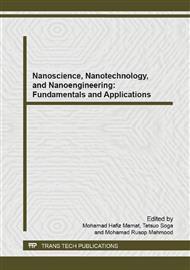[1]
K. Bewilogua and D. Hofmann, History of diamond-like carbon films: From first experiments to worldwide applications, Surface and Coatings Technology 242 (2014) 214-225.
DOI: 10.1016/j.surfcoat.2014.01.031
Google Scholar
[2]
Jalal Rauhi, M. Alimanesh, S. Mahmud, C.H Raymond, M. Rusop, A novel method for synthesis of well-aligned hexagonal ZnO nanostructures in field emission applications, Materials letters 125 (2014) 147-150.
DOI: 10.1016/j.matlet.2014.03.183
Google Scholar
[3]
A. Ishak, K. Dayana, and M. Rusop, Surface morphology and compositional analysis of undoped amorphous carbon thin films via bias assisted pyrolysis-CVD Advanced Material Research 667 (2013) 468-476.
DOI: 10.4028/www.scientific.net/amr.667.468
Google Scholar
[4]
D. Kamaruzaman, N. Ahmad, I. Annuar, M. Rusop, Semiconducting Properties of Nanostructured Amorphous Carbon Thin Films Incorporated with Iodine by Thermal Chemical Vapor Deposition, Japanese Journal of Applied Physics 52 (2013) 11NL02.
DOI: 10.7567/jjap.52.11nl02
Google Scholar
[5]
K. S. Han, J. H. Shin, and H. Lee, Enhanced transmittance of glass plates for solar cells using nano-imprint lithography, Solar Energy Materials and Solar Cells 94 (2010) 583-597.
DOI: 10.1016/j.solmat.2009.12.001
Google Scholar
[6]
Jalal Rauhi, M. Alimanesh, R. Dalvand, C.H Raymond, M. Rusop, Optical properties of well-alligned ZnO nanostructure arrays synthesized by electric field-assisted chemical bath deposition, Ceramic international 40 (2014) 11193-11198.
DOI: 10.1016/j.ceramint.2014.03.157
Google Scholar
[7]
H. Dai, Y. Zhang, Z. Chen, and F. Zhai, Investigating the structural and physical properties of hydrogenated amorphous carbon films fabricated by middle frequency pulsed unbalanced magnetron sputtering, Physica B: Condensed Matter 438 (2014) 34-40.
DOI: 10.1016/j.physb.2013.12.045
Google Scholar
[8]
X. Peng, Z. Barber, and T. Clyne, Surface roughness of diamond-like carbon films prepared using various techniques, Surface and Coatings Technology 138 (2001) 23-32.
DOI: 10.1016/s0257-8972(00)01139-7
Google Scholar
[9]
M. Rusop, X. Tian, T. Kinugawa, T. Soga, T. Jimbo, and M. Umeno, Preparation and characterization of boron-incorporated amorphous carbon films from a natural source of camphoric carbon as a precursor material, Applied surface science 252 (2005) 1693-1703.
DOI: 10.1016/j.apsusc.2005.03.215
Google Scholar


